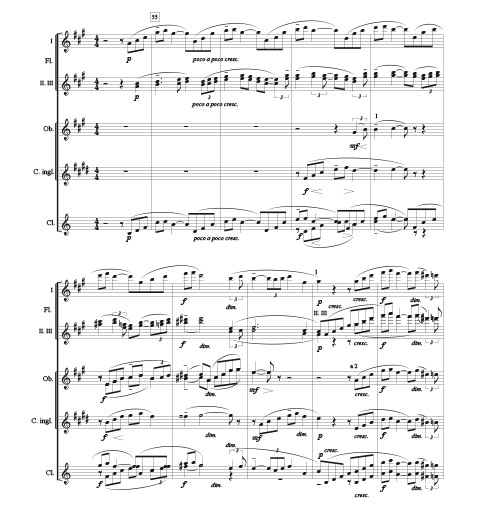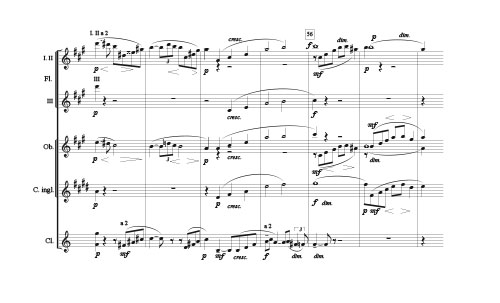Playing chamber music with your colleagues in orchestra is one of the most enjoyable aspects of orchestral life. The titles of principal flute and second flute imply that there is a hierarchy not only on stage but in the score. There are times when that is the case, but the lion’s share of orchestral playing is just complex chamber music on a large scale. Principals may believe that they are solo players and should always to be heard no matter the texture, while the tutti work is secondary. Second players may believe that they are subservient or their purpose is to make the principal sound good, but neither is true or artistic. The best results are achieved when principal and second flutes work together for the best and most appropriate balance, for the good of the whole, with each concentrating on fitting together as needed by the score. I am certain many musicians would agree that there is a particular pleasure in giving way so that another’s voice can come through the texture.
Who Am I Now?
When examining almost any score, flutists will see that their roles are complex and ever-changing. Some-times things are clear: the second or third flute has the harmony part for an entire passage, and the principal has the primary voice. Perhaps one flute or the other has a small solo that should cut through the texture. Interestingly, this is often the case with the third flute part. Sometimes voices move together in thirds or sixths, neither having a solo, but all parts blending with other instruments sharing that material, or some duo or trio passages are meant to be heard in relief with all flutes sharing the spotlight. In some styles the flutes have roles that may incorporate all of the above in one passage, requiring subtle use of chamber music skills, great technical and tonal control, and knowledge of the score.
Clueless
In the flute part there are few visible clues as to each person’s actual role. Often composers will courteously add the word solo above an entrance, but this is far from an explanation of the music’s true nature. English composers are famous for writing solo when the passage is nothing of the sort. Other times, solo can be literal and indicates that there is nobody else playing during that passage. This can be quite a surprise if you have not done your homework. Dynamics and other written indications are rudimentary. They are like a hallway sign pointing towards a distant door saying, Go This Way, without any indication of the door’s purpose, or what lies beyond.
Rachmaninov #2
Modern pieces are famous for their devilish complexity, but even in the standard Romantic repertoire, there are passages that are quite Byzantine. The following section from Rachman-inov’s Symphony No. 2, Third movement, (one of the most beautiful wind passages in the symphony,) illustrates how challenging things can be. Try to imagine how many subtle adjustments have to be made in order for all the voices in this passage to come through. (A full score would be helpful at this point. See partial score, wind parts only, on pg. 24.)
To play real chamber music within the orchestra, it helps to understand the context and basic construction of the passage. In the seven-part texture through the 7th bar of 55, Rachmaninov has given the principal motive of the movement (heard at the beginning) to the principal flute and clarinet. This motive is now used as an accompaniment to the melody (not shown) heard earlier in the lower range of the violins at 47. Here that melody takes a stronger central role, played again by the violins at mf in octaves. Winds are marked p, and must gauge their level according to the strength of the violins. The cellos play the obbligato, the harmony part is in the second and third flutes, divisi violas (not shown), and oboe, and horns, secondary cellos, and basses (not shown), along with bassoons, play the two-part fundamental harmonic layer. Bass clarinet, horn 1, English horn, and clarinet 2 interject the first theme in imitation. Obviously, for all of this to be heard, there has to be a great deal of creative giving way, especially within the structure of each measure. For example, flute 1 plays a little softer just a bit after the downbeat, so the moving voices in flutes 2 and 3 can be heard in the flute section.
In bars 8-9 after 55, the top voices coalesce around the primary theme, the harmony parts are played by the brass. Bass clarinet, bassoons, and horns take the primary theme in augmentation (quarter notes instead of the usual eighths). Four bars before 56, the theme extends and fragments into many parts. Second flute takes a solo role with the second oboe at 56. As a result, flute 1 and others cannot play a literal forte in the sustained C# at 56 or it will interfere with the solo.
In such a complex passage as this, where many voices compete for attention, knowing when to give way and let the other player through is just the beginning. Listening skills and attention to basic chamber music practices are important. With the many doublings, intonation can be very problematic, as is finding the right balance between blending with other instruments, blending with the section, and emerging proportionally when playing the moving line. Split-second timing and rhythmic flexibility are required to maintain the flow as the melodic material constantly changes hands. The balance between one’s own sense of the pulse, the perception of the conductor’s beat, and the rhythmic interpretation of numerous musicians can be challenging to achieve. One must pace crescendo and diminuendo carefully along with one’s colleagues in perspective with the whole texture.
More specifically, note that the second flute, in the course of this one passage, begins in a quasi-accompanimental role (in harmony with flute 3), then moves to a reinforcing role at the peak of the phrase (with a unison forte with flute 1 and 3 but without interfering with the sound of flute 1), changes to a ghosting role (4 before 56 in unison with flute1 and at a piano dynamic), and finally has a solo appearance at 56 that has to be extremely full to cut through at all. None of this can be perceived by looking only at the second flute part. Most importantly, a different sound and use of vibrato should accompany each role. For example, the solo at 56 can have a full, rather continuous vibrato – if that is appropriate in the section. The ghosting role should be exactly opposite in nature: no vibrato, pp, and less present and focused in the tone.


Give Way
Rachmaninov’s music, with its extremely dense contrapuntal texture and emphasis on extremes, is like a huge buffet in which all of the dishes are delicious and compete for attention on the plate. With so many beautiful lines in the texture, the music easily becomes muddled and constantly loud unless careful discretion is used on the part of the individual players in their respective roles. Many performances of Rachmaninov’s music are criticized for this fault.
A chamber music approach to orchestral playing enhances works written in all styles, and all repertoire requires the same global awareness on the part of players and conductors. Whether Rachmaninov, Debussy, or Mozart is on the program, it takes time, knowledge and effort on the conductor’s part to achieve clarity in the texture. Things come together much more smoothly if the players are attentive to their roles. Take the time to understand your role and increase your appreciation of orchestral playing. Do your homework, and then give way.
* * *
Be a Detective:
How to Discover
Your Role in a Piece
1. Find a score
2. Listen to several performances or recordings and note differences in interpretation.
3. Prioritize the music: mark which parts look and sound like they should stand out. Clues can be the dynamics, texture, primary and secondary melodies, or form. What looks and sounds like an accompaniment vs. the tune? You could even play some of the other parts to gain knowledge and have fun.
4. Cross-reference those markings with the flute part. Write various prompts into your part to listen for various instruments. Basically, know if you play a central part, or an auxiliary part. (It is interesting to note that some composers, such as Berg and Schoenberg developed a system to indicate precisely these characteristics in their orchestra parts.) If you have some knowledge of music theory, it can help with understanding the harmony, which helps with characterization, intonation and interpretation.
5. Avoid making your part too complex with added markings. Find an efficient system that helps you listen more and focus on your role as you play.
6. Be flexible. Learn to play your part at different tempos and dynamics.
7. Develop better chamber music and listening skills. Practice duets with a friend. Work primarily on balance (achieving a similar approach to tone and dynamics), giving way, and intonation.






